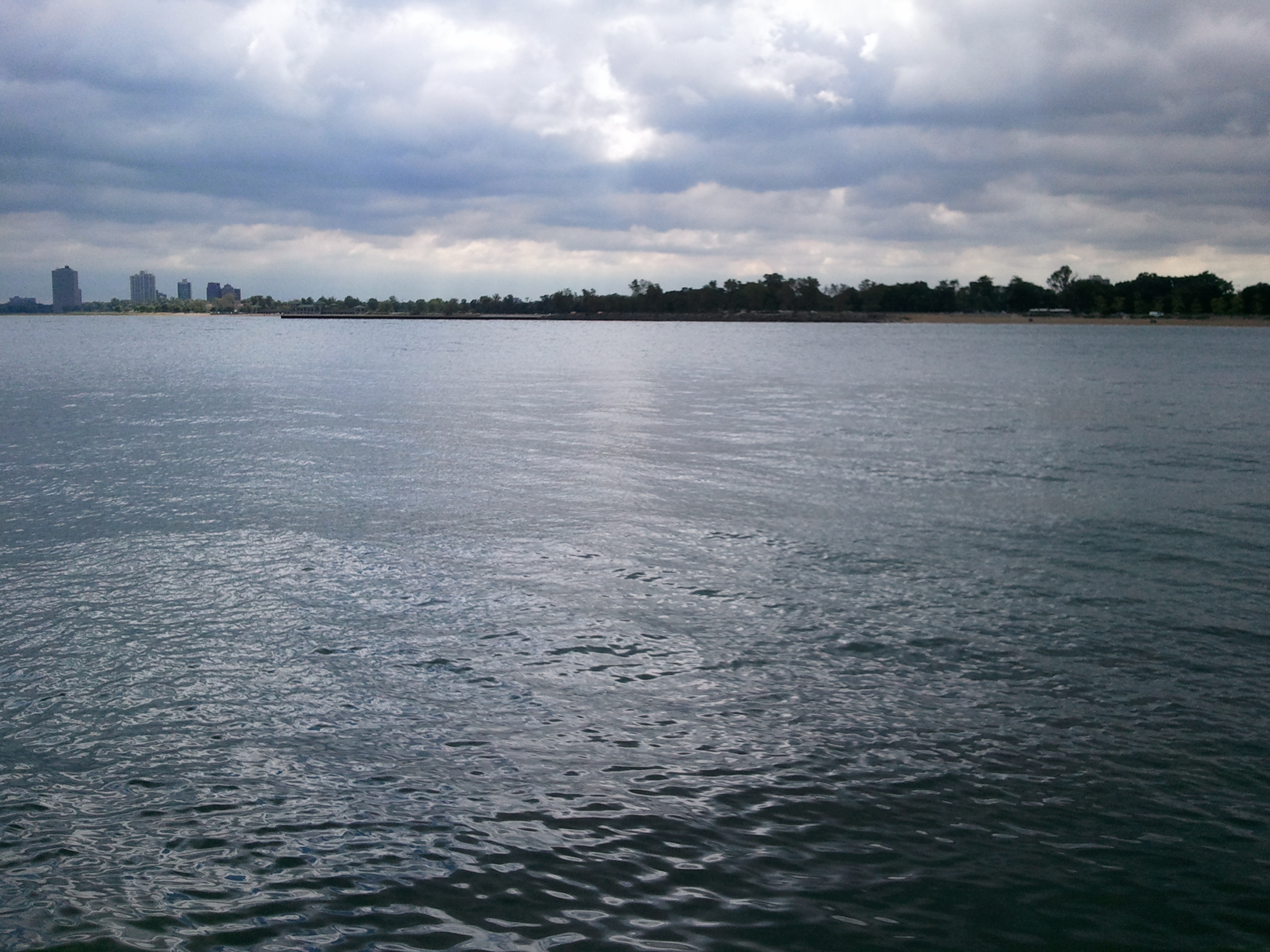Swimming at Chicago’s Promontory Point
Summer’s almost gone in Chicago. The winds are picking up; white caps on the lake are a little more frequent; the morning temperatures have a little more bite; the evenings a little less light. Soon, the lake will turn over, bringing the cold depths to the surface, and the air will fail to warm them.
So, it’s about time that I write about my favorite little corner of Lake Michigan: the cove formed by the southern face of Promontory Point and the 59th Street Pier, with the 57th Street Beach in between. “The Point” has been used by long-distance swimmers for decades, who appreciate its several unique features:
- deep water - as soon as you step off the Point, you’re in 10-18 feet of water all the way across to the Pier
- easy distance measurement - the four city blocks between the Point and the Pier are an even half-mile, for a one-mile round-trip
- sighting buoys - May through September, a series of six buoys guide you between Point and Pier, though both structures are easily sight-able from the opposite side. These buoys also protect swimmers from boat traffic, which must stay outside the buoy line.
- ladders - two heavy-gauge ladders are permanently welded to the southeastern tip of the Point, allowing easy water access even to the most “senior” swimmers
- ease of access - the Point is less than a 10 minute walk from the 55/56/57th St. CTA bus stops and readily available parking.
- friends, not crowds - it’s easy to find swim buddies at the Point, but it’s almost never crowded the way Ohio Street Beach can get. A regular group swims weekdays at 6am and weekends/holidays at 7am, but you can often find people around noon or early evening. Point swimmers run the gamut from those just looking for a quick dip to those who want a serious workout - and everything in between.
Here’s a satellite image of the swim area, showing approximate distances:
Most people just follow the buoy line, but you can mix things up with a trip to the 57th Street beach. Point-to-Pier is 750m as a straight line, but the buoys run slightly outside the line drawn above, which makes that path closer to 800m. The triangle shown above is a total of 1700m.
While most people swim on the south side of the Point, the north side also provides a nice (albeit shallower) swim zone, with a protected cove, small beach, and buoys during the summer. Swimming on the north side of the Point is technically illegal - it’s not an officially sanctioned “swimming beach” - but this doesn’t appear to be actively enforced.
The Point also provides natural protection against swells and chop, depending on the wind direction. With a north wind (swells coming from north to south), the north side of the Point bears the brunt of the action, which protects the south side. With a south wind, the opposite occurs.
Yesterday we had northeast winds. Here’s what the north side of the Point looked like:
And here’s what we had on the south side of the Point:
I took these pictures within 5 minutes of each other!
The water has been holding steady in the mid-60s, but the “Point penguins” know time is short, and the lake will soon become inhospitable to even the hardiest among us. “50 to 50” is oft-heard saying - that is, 50 degrees (spring) to 50 degrees (fall). Most likely, we have less than a month remaining of temperatures reliably in that zone.
After that, it’s “see you in the spring!”
Marathon Swimming History at the Point
Promontory Point is arguably among the most historically significant swim spots in America, right alongside San Francisco’s Aquatic Park and La Jolla Cove. The Point was the primary training location of four Marathon Swimming Hall of Famers:
- Ted Erikson - First person to swim across Lake Michigan (1961). One of only two to swim from the Farallon Islands to San Francisco (and record-holder since 1967). Former record-holder for two-way English Channel swim (1965-1975).
- Jon Erikson - First three-way English Channel swim (1981). Former record-holder for two-way English Channel (1975-1987) and youngest one-way (14 years old in 1969). 31 professional marathon swim races.
- Conrad Wennerberg - coach and training partner of the above three, and author of Wind, Waves, and Sunburn.
- Dennis Matuch - training partner and contemporary of Ted Erikson.
The Point was constructed from landfill and opened as a public park in 1937. With Hyde Park and the University of Chicago nearby, it soon became a popular swim spot. Marathon swimmers have trained there at least since the early 1960s. As Ted Erikson explains (via personal communication):
In prepping for the 1961 Lake Michigan Swim to Michigan City, I began swimming off the rocks from Jackson Park Harbor entrance to 67th St. Beach (1/2 mile course) late fall and early 1961.
Conrad Wennerberg, who I met at 67th, suggested the Point, where I occasionally swam to from 67th. The Point seemed more social. So, I started off and on in 1961 and continuously from 1962 to present.
Similar to what we do nowadays, the Point Swimmers of the ’60s swam “laps” between the southeast edge of the Point and the 59th Street Pier (a 1-mile round-trip). Ted recalls:
Dennis and I would push each other for 1-10 mile training swims. Most interesting were 1-milers with slow swimmers starting early and fast swimmers starting late such that ALL would reach the final buoy about 100 yards from finish at the same time. This made a nice race to finish for all which included Connie, Bill Tregay, Tom Lisco, Mike Paesler, Jon, and others, some who “handicapped their time” obviously beat us because of “saving” themselves for the sprint.
Was great fun, competition, and good training. Once Dennis found a foot at the finish, and holding it up, breathing heavily from the sprint, said “Who lost their foot ?”… (foot was from a passenger on a United Airlines plane that crashed off the Point a week so before).
Despite this rich history, the Point keeps a low profile even in Chicago - and even among swimmers. The city’s enthusiastic triathlete population primarily trains downtown at Ohio Street Beach, the site of Big Shoulders. (One might argue, this is a good thing.)
One reason is the Point’s relative isolation, 7 miles south of downtown. Another reason: Until recently it was technically illegal to swim off the Point. A few swimmers, including Ted, were even arrested in the late 1980s. But Ted and others held their ground and, through the power of community organizing (a Hyde Park specialty), pressured the Chicago Park District to create a designated “long distance swimming area” offshore from 57th Street Beach.
The politics of the Point makes for fascinating reading. For more, see this 2001 article from the Tribune.



